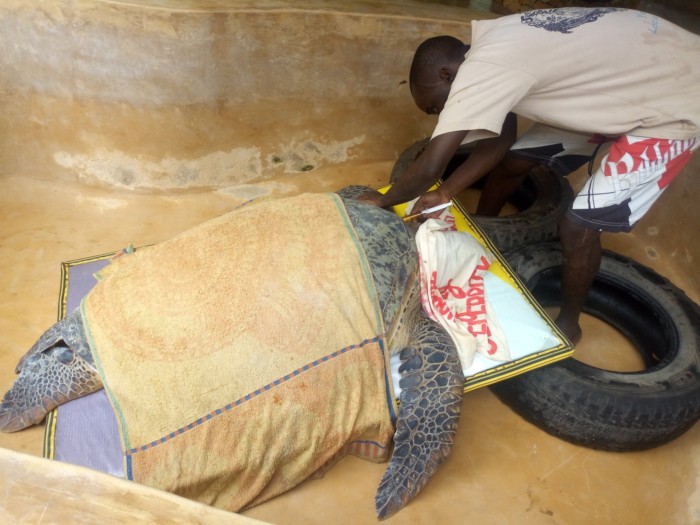
Kilifi,KENYA:On a concrete slab at the Watamu Turtle Watch, a sea turtle lies on its shell.
The anaesthesized green sea turtle has been lying on the concrete slab for the past two hours undergoing a laser procedure to remove tumors some the size of a golf-ball from its flippers, belly and eyes.
According to Kahindi Changwa one of the team members who conducted the operation, the sea turtle was brought to the centre the previous day after it was rescued starving and stranded in the shores of the nearby Indian Ocean.
“This turtle was really suffering, It cannot like express its pain like other mammals but you could see from its eyes and groans it was in pain and we have successfully removed more than 15 tumors from its body” Kahindi explains.
Kahindi explains that after 3 hours at the centre, the 139 kilogram adult sea turtle should be ready to go back to its natural habitat.
The sea turtle is suffering from Fibropapillomatosis (FP) a disease caused by strain of the herpes virus found in almost all species of sea turtles but prevalent among green sea turtles.
The Watamu Turtle Watch which has been running a turtle clinic and rehabilitation program for injured and sick sea turtles has so far treated 870 turtles since its inception in 2002 and 160 of those have gone through the procedure to remove the cauliflower like tumors.
But what causes the disease?
Scientitists trace the disease back to 1938 when it was first discovered in Florida before it seriously reappeared in the 1980’s.
It is not yet clear when the disease first was first detected on sea turtles on Kenyan waters and Gladys Okemwa the fisheries and conservation research officer at the Kenya Marine and Fisheries Institute says the disease has been there for more than 20 years but has been increasing rapidly over the past years causing a decline on the turtle population.
A research conducted in 2010 linked the disease to polluted waters.
According to the research conducted at the Hawaii islands where the the prevalence rate is as high as 92%, all sea turtles have a dormant herpes virus which is awakened when turtles feed on niotrogen fed algae and seaweed .
The nitrogen generates an amino acid block called arginine in their bodies hence generating the tumors.
Nitrogen which finds its way into sea waters from sewerage waters acts as a fertilizer to seaweed.
Once a turtle is infected, it can infect another turtle through mating and at birth.
Okemwa explains the tumors not fatal however they affect the immune system of the turtle leading to opportunistic infections.
“ The tumors as they multiply impair a turtles vision, diving and feeding ability and that inturn affects its functionality opening the window to opportunistic infections and at this stage the turtle cannot evade predators and eventually it will die from the infections ” Okemwa explains.
Fibropapillomatosis has no cure or vaccine, a high chance is that once Kahindi and his team release the operated turtle back into the ocean, the tumors they worked so had to remove might sprout back continue infecting other turtles.
“What we are doing is basically trying to prolong the turtles life cycle but we cannot completely cure the tumors,” Kahindi explains.
According to a research conducted on turtles in Lamu based on mortality data spanning from 2001 to 2013, Fibropapillomatosis was the third leading cause of death in turtles at 11%.
The sad life of sea turtles
Sea turtles have a sad lifecycle, with all the sea turtle species being listed as endangered by the International Union for Conservation of Nature, the turtles woes begin at the egg stage where their hatch rates are 1 hatchling for every 1000 eggs laid.
Turtles lay their eggs at the shorelines and it has been a widespread belief that turtle eggs can cure impotency.
Once the hatchling is out, it has to evade predators such as crabs and sea birds when crawling into the ocean.
Though turtle fishing is illegal, experts say there exists lucrative black market for turtle meat with the research conducted in Lamu indicating that fishing and bycatch had a mortality rate of 51% on turtles.
Little research has been conducted in the country about Fibropapillomatosis.
Glady’s attributes this phenomenon to the fact that turtles can swim for thousands of miles when migrating making it difficult to track them.
“ It is very difficult because this reptiles are out there, you cannot monitor who they mate with, their feeding and habitat conditions so the only way you can control the infection is by maybe controlling sea pollution and that’s why turtles are used as a flagship species for the environment,” Gladys says.












